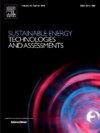开放式实验室刀击钻机,用于评估鱼类受伤和死亡的风险,并测试被动传感器
IF 7
2区 工程技术
Q1 ENERGY & FUELS
Sustainable Energy Technologies and Assessments
Pub Date : 2025-07-17
DOI:10.1016/j.seta.2025.104427
引用次数: 0
摘要
水力发电是一种重要的电力来源,可对水生生态系统产生负面影响。通过水力发电设施下游的鱼类可能面临与水力结构和机械发生机械碰撞而受伤和死亡的风险增加。实验室测试为评估涡轮叶片撞击风险、研究活鱼的伤害和死亡率提供了受控环境。以前的实验室叶片冲击钻机在设计和实施上存在很大差异,缺乏一种标准化的方法来控制叶片速度,以实现交叉比较的结果。为了解决这个问题,我们提出了一个开放的实验室叶片撞击试验台,该试验台具有电子控制的叶片速度(1-10 m s-1)。此外,还进行了刚性传感器测试,以研究95g适合评估叶片撞击严重程度的建议,在撞击速度低至1 m s-1时,超过了这一建议。这项工作意义重大,因为它为水电、工程和生物界提供了第一个开放和标准化的方法来评估叶片对鱼类和传感器探头的影响。该试验台可以收集生物阈值数据,以估计活鱼的伤害和死亡率,评估涡轮叶片设计,以提高鱼的安全性,并提高传感器探头的准确性,而无需依赖于活鱼的现场研究。本文章由计算机程序翻译,如有差异,请以英文原文为准。

An open laboratory blade strike rig to evaluate the risk of injury and mortality to fish and to test passive sensors
Hydropower is a key source of electricity that can negatively impact aquatic ecosystems. Fish passing downstream through hydropower facilities may face increased risks of injury and mortality from mechanical collisions with hydraulic structures and machinery. Laboratory tests provide a controlled environment to evaluate turbine blade strike risks, studying injury and mortality in live fish. Previous laboratory blade strike rigs vary substantially in design and implementation, lacking a standardized approach with controlled blade velocities for cross-comparable results. To address this, we propose an open laboratory blade strike test rig with electronically controlled blade velocities (1–10 m s-1). In addition, rigid sensor tests were performed to investigate the recommendation that 95 g is suitable to assess the severity of the blade strike, which was exceeded at strike speeds as low as 1 m s-1. This work is significant because it provides the hydropower, engineering and biological communities with the first open and standardized method to evaluate blade strikes on fish and sensor probes. The proposed test rig enables gathering biological threshold data to estimate injury and mortality to live fish, assessing turbine blade design for improved fish safety, and increasing sensor probe accuracy without relying on live fish field studies.
求助全文
通过发布文献求助,成功后即可免费获取论文全文。
去求助
来源期刊

Sustainable Energy Technologies and Assessments
Energy-Renewable Energy, Sustainability and the Environment
CiteScore
12.70
自引率
12.50%
发文量
1091
期刊介绍:
Encouraging a transition to a sustainable energy future is imperative for our world. Technologies that enable this shift in various sectors like transportation, heating, and power systems are of utmost importance. Sustainable Energy Technologies and Assessments welcomes papers focusing on a range of aspects and levels of technological advancements in energy generation and utilization. The aim is to reduce the negative environmental impact associated with energy production and consumption, spanning from laboratory experiments to real-world applications in the commercial sector.
 求助内容:
求助内容: 应助结果提醒方式:
应助结果提醒方式:


